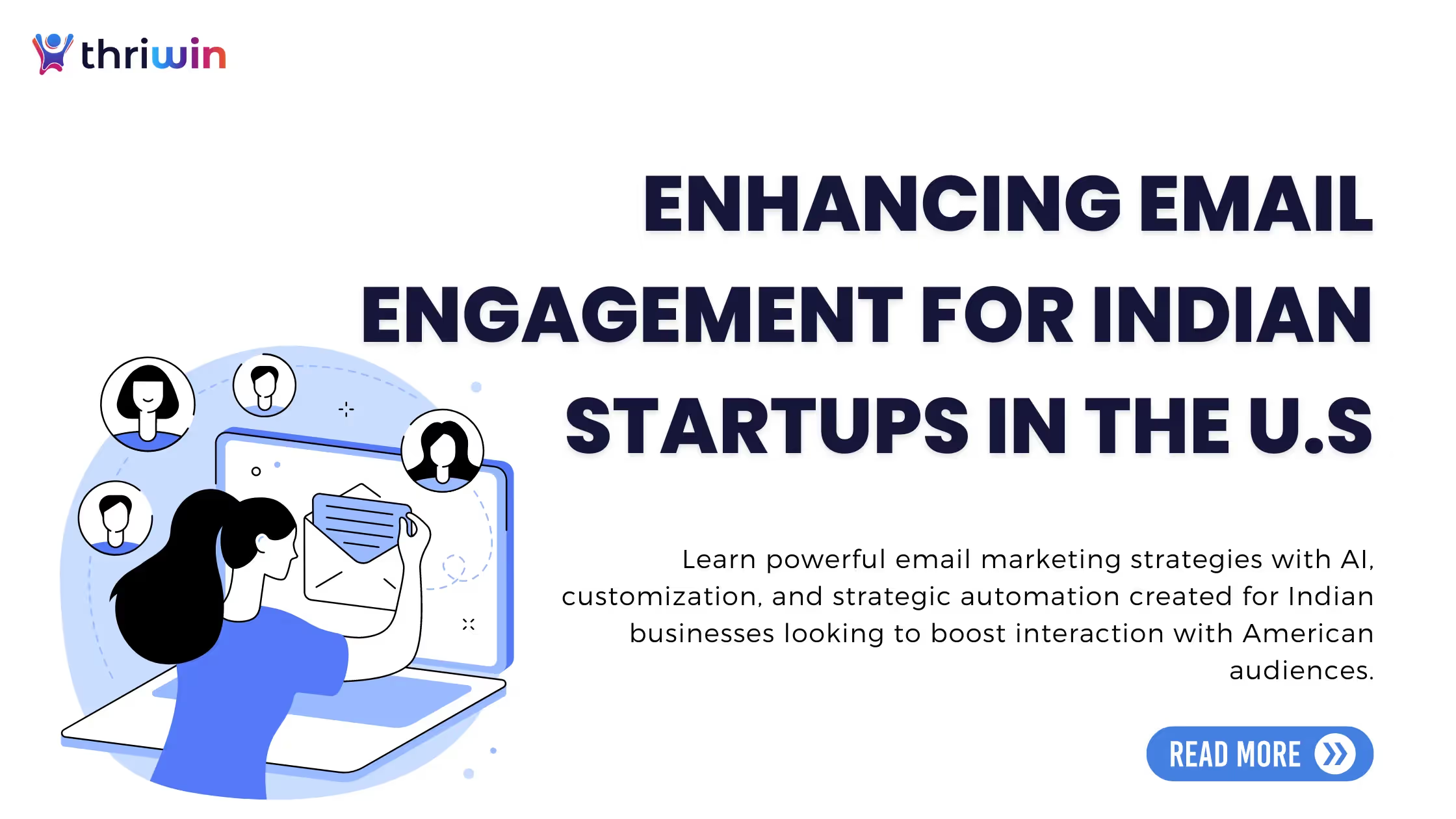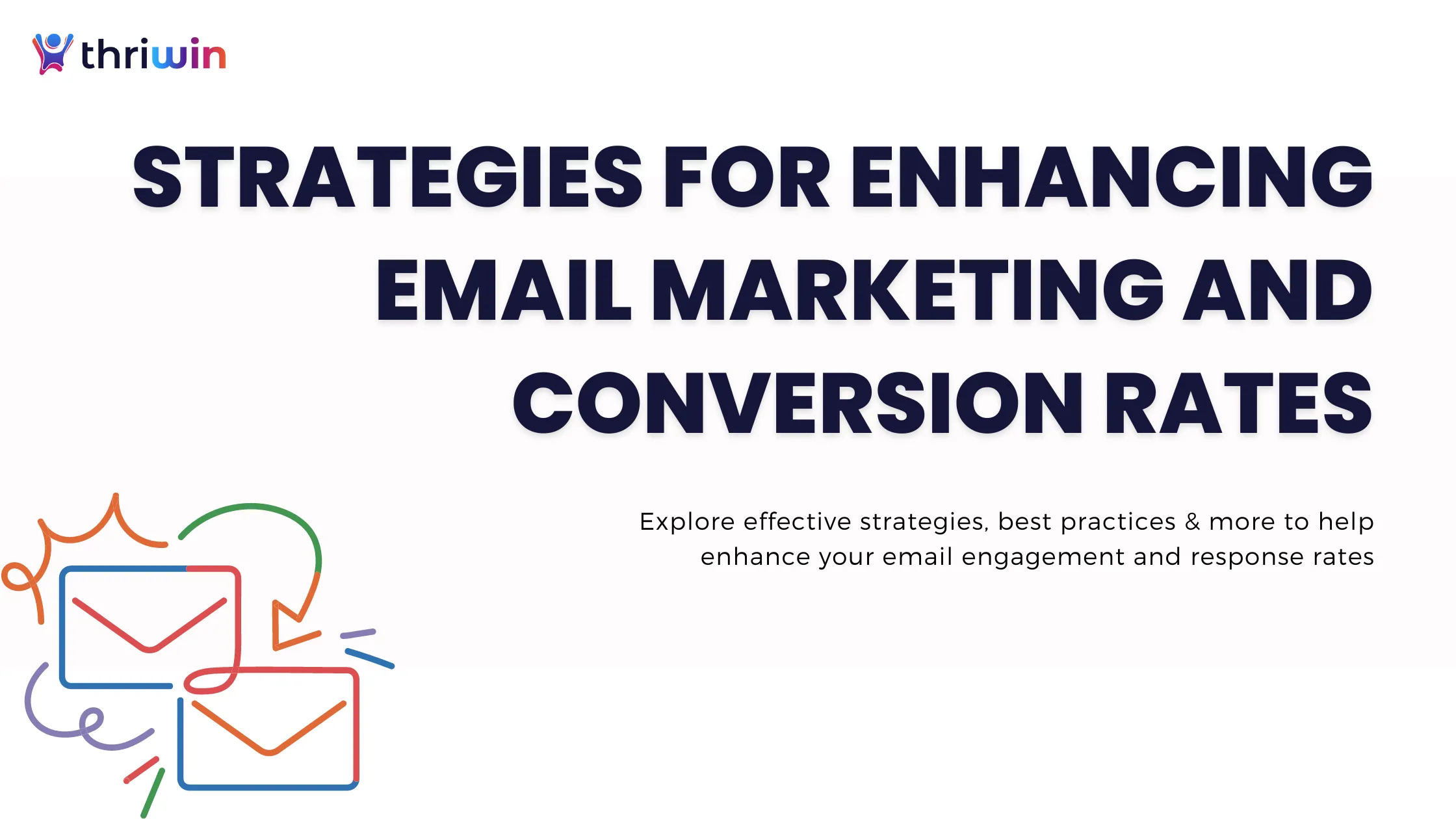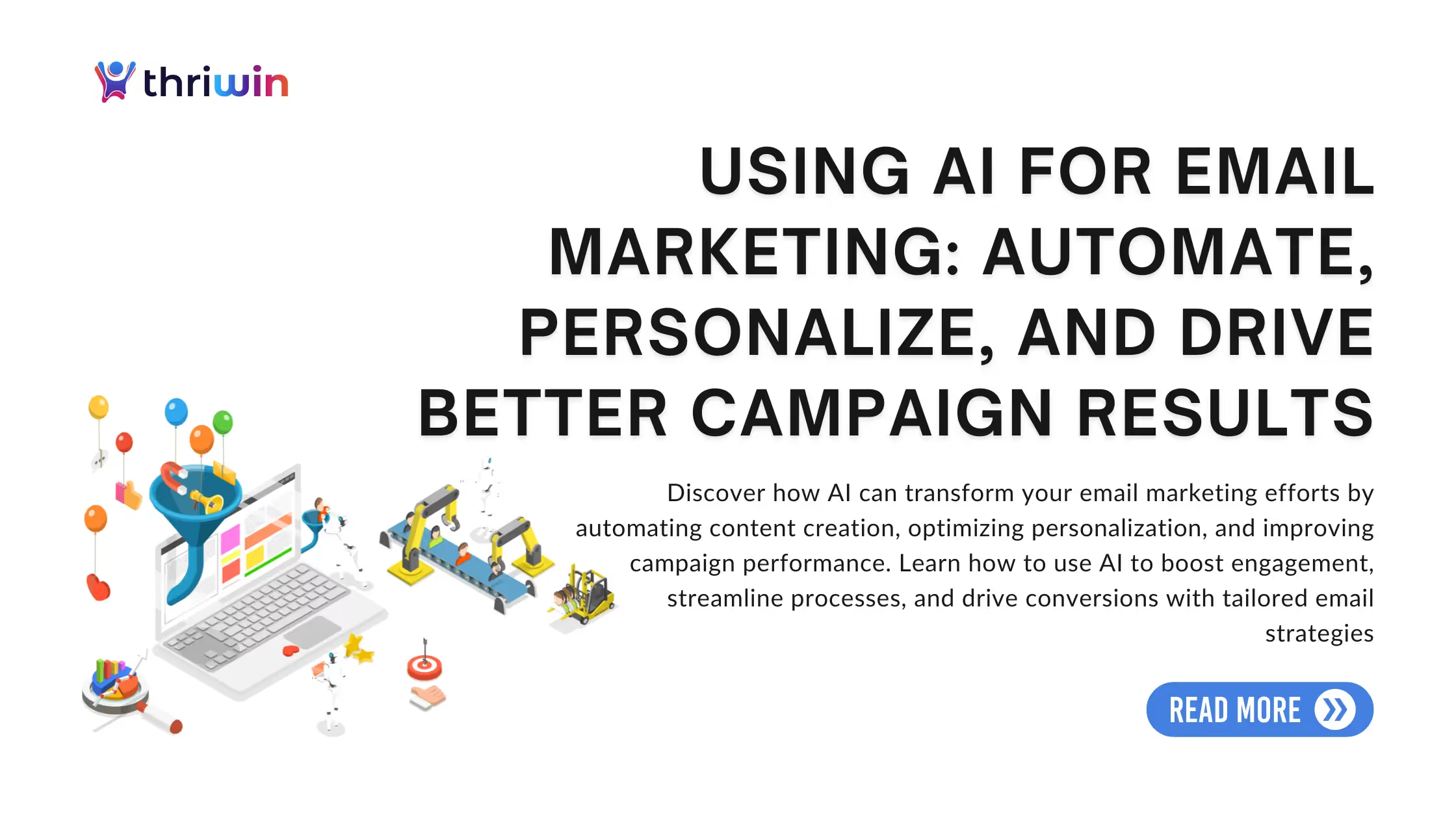Planning an email marketing campaign but worried about what content you could use to ensure high CTRs? As per studies, that 47% of email recipients open email based on the subject line whereas 69% of email recipients report email as spam based solely on the subject line. Most marketers agree that email marketing is crucial for businesses to connect with their audience through targeted and customized communication. However, crafting the perfect message can be pretty challenging. With generative AI tools like ChatGPT, creating engaging email content has become less time-consuming. By using ready-made prompts, marketers can save time, boost engagement, and ensure their communication resonates with recipients more effectively.
AI tools like ChatGPT are transforming the way marketers create email campaigns. Instead of starting from scratch, marketers can use prompts to generate content tailored to their audience's needs. This saves time and ensures higher quality, as the prompts can help create more personalized, engaging, and persuasive emails. Whether it's a welcome email, a promotional message, or a follow-up, ChatGPT can provide the right prompt to enhance the effectiveness of your email marketing efforts.
Understanding Email Marketing Prompts
Email marketing prompts are handy tools that help marketers quickly craft engaging email content. These pre-designed sentence starters guide your tone and messaging, making it easier to connect with your audience. For example, a prompt like, “Struggling with [Problem]? Here's the solution...” grabs attention and sets the stage.
Prompts save time, beat writer’s block, and keep your emails consistent. Whether your goal is to increase engagement or drive sales, prompts can be tailored to match your strategy. A simple prompt like, “Only [Number] days left to save on [Product]” can create urgency and encourage action.
How ChatGPT Transforms Email Marketing with AI-Driven Prompts
ChatGPT is a powerful generative AI tool that has revolutionized how email marketers create content while boosting the impact of their campaigns. It simplifies the process of drafting personalized and engaging emails and can also help marketers save valuable time by generating different types of content using relevant prompts. Whether you're crafting subject lines, body content, or follow-up sequences, ChatGPT’s ability to tailor responses to specific audiences makes it an essential tool in modern email marketing.
Let’s explore how ChatGPT can enhance your email marketing strategy in details:

1. Efficient Content Creation
ChatGPT turns simple prompts into polished email content, from catchy subject lines to persuasive calls to action, in seconds. This saves time, helps avoid repetitive messaging, and sparks fresh ideas. ChatGPT ensures your content resonates with your audience, whether for promotional emails or newsletters.
2. Enhanced Personalization for Better Engagement
ChatGPT enhances email marketing personalization by tailoring content to each recipient's unique preferences, such as their name or purchase history, making emails more relevant and engaging. Personalization boosts open rates by 26%, leading to higher conversions and improved ROI. By customizing emails with ChatGPT, marketers can significantly increase engagement and drive better results. For more insights, check out the source
3. Optimizing Emails with A/B Testing
ChatGPT also assists with A/B testing by generating multiple versions of email content. Marketers can easily input different prompts and receive variations of subject lines, email bodies, and CTAs. This flexibility makes it simple to test which version performs better with your audience. Marketers can continuously optimize their email strategies by comparing results from different versions and improving engagement rates over time.
4. Creating Dynamic Email Content
With ChatGPT, marketers can generate dynamic email content that adapts to user interactions. Whether real-time personalization based on user behavior or dynamic content that adjusts based on recipient preferences, ChatGPT allows for more interactive and engaging email experiences. This adaptability makes your campaigns more responsive and aligned with customer expectations, ensuring that each recipient gets a more personalized and relevant message.
5. Automating Email Campaigns
ChatGPT can also automate various parts of your email marketing workflow. From creating templates for different stages of the customer journey to drafting follow-up sequences, ChatGPT can help streamline the process, ensuring timely and consistent communication with leads and customers. Automating these touchpoints allows marketers to focus on strategy while ensuring no engagement opportunities are missed.
14 Best Prompts for Email Content Ideas
Creating unique email content is crucial to standing out in a crowded inbox, especially in competitive markets. It can be challenging to come up with fresh, original ideas that captivate your audience. Fortunately, using ChatGPT, marketers can ideate faster and generate compelling email content that resonates with their subscribers.
Let’s explore various prompt categories to help you brainstorm email content ideas and enhance your email marketing strategy.
1. Festive and Holiday Email Campaigns
Creating holiday-themed emails is a proven way to resonate with your audience. Whether it’s for Black Friday, Christmas, or other holidays, these campaigns allow you to connect with your customers when they are actively looking for deals or special offers. By incorporating festive elements, you can tap into the excitement and relevance of the season, helping your emails stand out in crowded inboxes. Additionally, you can tailor these emails to reflect your brand’s unique offerings, ensuring your campaigns remain fresh and engaging.
Prompt:
"Generate 6 festive-themed email ideas for a [beauty brand] promoting holiday sales, focusing on Christmas and New Year offers."
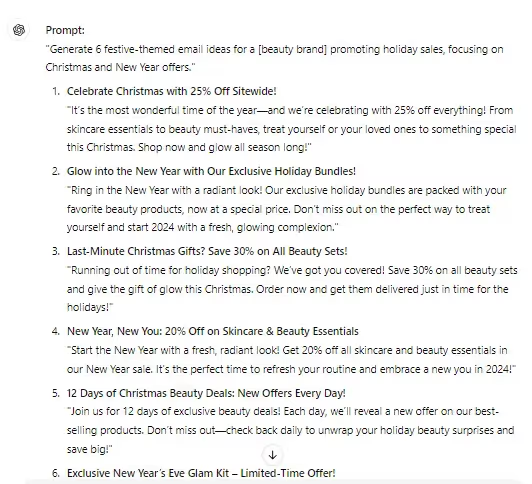
2. User-Generated Content (UGC) Email Ideas
User-generated content is a powerful way to engage your audience by showcasing real customer experiences. Whether it’s featuring customer testimonials, photos, or social media mentions, UGC helps build trust and credibility for your brand. Emails that highlight UGC not only provide social proof but also encourage other customers to engage with your brand. You can create campaigns that invite your audience to share their own content, participate in contests, or simply highlight their feedback in your email newsletters.
Prompt:
"Create 4 email ideas that incorporate user-generated content for [a fitness brand] to highlight real customer stories and results."
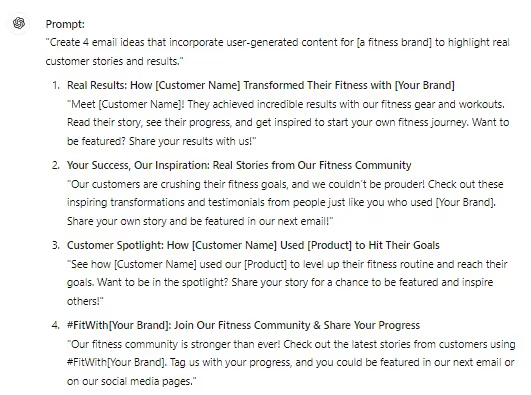
3. Limited-Time Offer Emails
Limited-time offers create a sense of urgency and can significantly boost conversions. When you communicate the time-sensitive nature of your promotion, customers are more likely to act quickly. These emails are ideal for flash sales, seasonal discounts, or product launches, where driving immediate action is the goal. Highlighting the limited availability or exclusive nature of the deal will entice recipients to take advantage of the offer before it’s too late, ultimately increasing engagement and sales.
Prompt:
"Generate 6 email content ideas for a flash sale campaign for [an electronics retailer], emphasizing urgency and limited-time discounts."
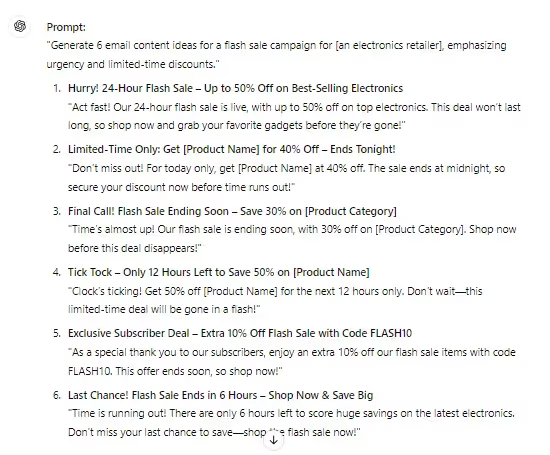
4. Product Launch Email Campaigns
Introducing a new product to your audience requires a well-crafted email campaign that builds anticipation and excitement. Product launch emails should not only highlight the features and benefits of the new item but also create buzz through teasers, early access for loyal customers, or special launch offers. Your email series should take customers through a journey—introducing the product, sharing its benefits, and offering a clear call to action. This ensures that your launch is not only informative but also enticing.
Prompt:
"Create 5 email content ideas for a product launch campaign for [a tech gadget company], focusing on features, benefits, and early-bird offers."
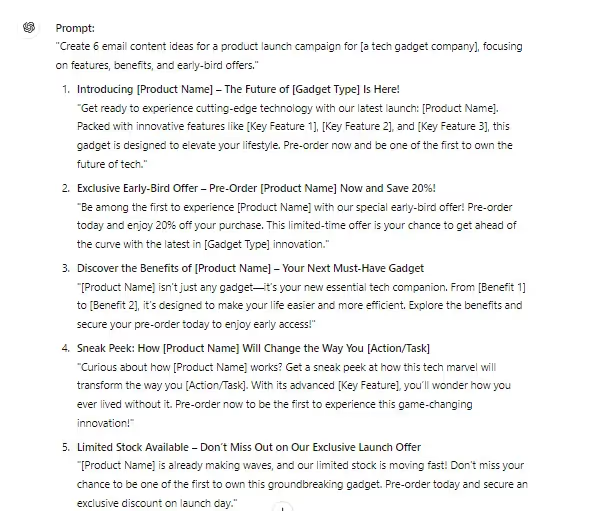
5. Re-Engagement Email Campaigns
Over time, some of your email subscribers may become inactive, but that doesn’t mean they’re lost forever. Re-engagement emails can bring back these inactive users by reminding them of the value your brand offers or by providing incentives to return. Whether through special offers, new product announcements, or simply reminding them of what they’re missing, re-engagement campaigns are an effective way to reignite interest. These emails should feel personal and welcoming, encouraging recipients to reconnect with your brand.
Prompt:
"Generate 5 email content ideas for re-engaging inactive subscribers of [an online clothing store], including special discounts and new arrivals."
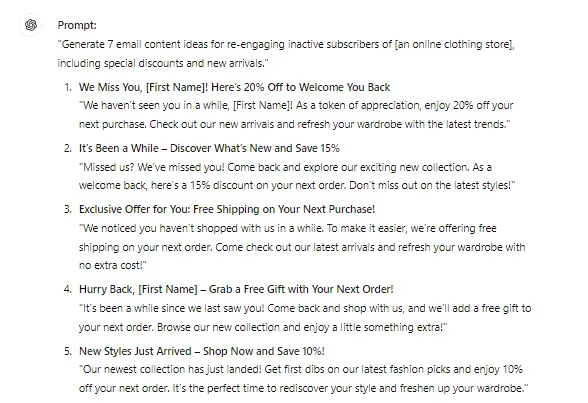
6. Personalized Birthday Emails
Personalized birthday emails are a great way to build a positive relationship with your customers. A well-timed birthday email shows that you appreciate and celebrate your customers, making them feel valued. Offering a special birthday discount or free gift as part of the email will further incentivize them to engage with your brand. These emails tend to have high open rates and can drive loyalty while boosting sales, as recipients are more likely to treat themselves during their birthday month.
Prompt:
"Create 5 birthday-themed email ideas for [a skincare brand], including personalized discounts and free gift offers."
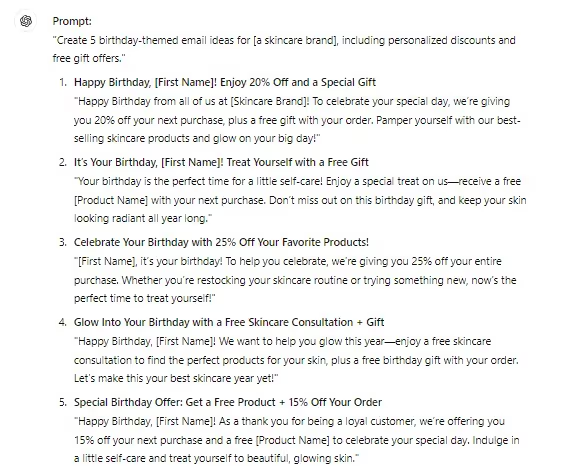
7. Customer Appreciation Emails
Customer appreciation emails are a great way to acknowledge and thank your loyal customers. These emails help foster long-term relationships by showing gratitude for their continued support. Offering exclusive deals, early access to sales, or loyalty rewards in these emails can enhance customer satisfaction and encourage future purchases. The goal is to make your customers feel valued, creating a sense of connection and appreciation that strengthens brand loyalty.
Prompt:
"Generate 8 email ideas for a customer appreciation campaign for [a subscription box service], offering special deals and loyalty rewards."

8. Educational and How-To Emails
Providing educational content in your emails helps establish your brand as an expert in your field. Educational or how-to emails can include tips, tutorials, or product usage guides that offer real value to your customers. By teaching your audience something new, you increase the likelihood that they’ll engage with your content and trust your brand. These emails work particularly well for brands offering complex products or services, as they help simplify the customer experience.
Prompt:
"Create 5 how-to email content ideas for [a DIY home improvement brand], offering practical tips and product usage tutorials."

9. Seasonal Product Highlight Emails
Each season brings new opportunities to showcase relevant products. Whether it’s winter coats in the colder months or beachwear during the summer, seasonal product highlight emails help you connect with your audience’s immediate needs. These emails should focus on showcasing the best seasonal products, highlighting their benefits, and tying them into the lifestyle of your target audience. Including seasonal promotions or limited-time offers can further encourage purchases.
Prompt:
"Generate 6 seasonal product highlight email ideas for [a fashion retailer], showcasing winter collections and promotions."

10. Event Invitation Emails
Inviting your customers to attend an event, whether virtual or in-person, is an excellent way to foster deeper connections. Event invitation emails should convey excitement and provide all the necessary details—such as date, time, location, and agenda—clearly and concisely. You can also include a compelling call-to-action, such as signing up for early bird tickets or reserving a spot. These emails should make it easy for recipients to understand the value of attending your event and encourage them to RSVP.
Prompt:
"Create 5 event invitation email ideas for [a SaaS company], promoting upcoming webinars and industry events."
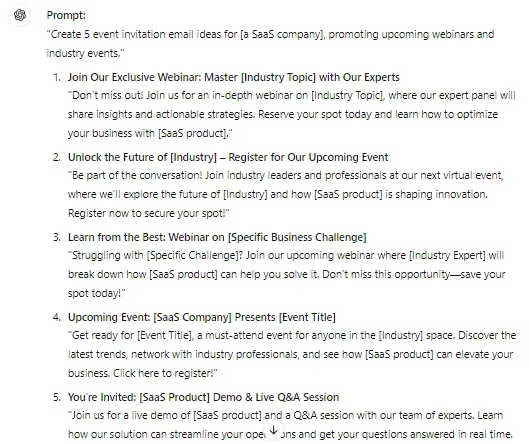
11. Cart Abandonment Emails
When a customer abandons their online shopping cart, it represents a missed opportunity for conversion. Cart abandonment emails are a proven way to recover these lost sales by reminding customers of the items they left behind. Including product images, pricing, and a clear call to action can encourage customers to return and complete their purchase. Offering additional incentives, such as free shipping or a discount, can further boost conversion rates.
Prompt:
"Generate 7 cart abandonment email content ideas for [an eCommerce furniture store], including incentives like discounts and free shipping."
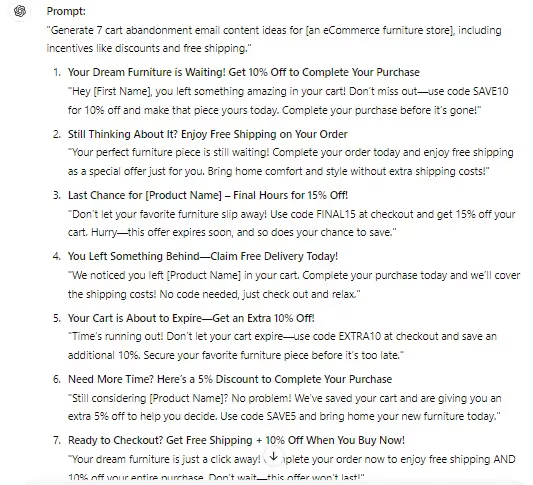
12. Subscription Renewal Reminder Emails
For subscription-based services, keeping customers engaged and reminding them to renew is crucial. Renewal reminder emails should be clear and timely, providing enough notice for customers to renew without feeling rushed. Highlight the benefits of continuing the subscription and, if possible, offer incentives for early renewal. These emails should make it easy for the recipient to take action, with a straightforward call-to-action and a reminder of the value they’ll receive by staying subscribed.
Prompt:
"Create 6 email content ideas for a subscription renewal reminder for [a meal delivery service], focusing on the benefits of continued service and early renewal discounts."
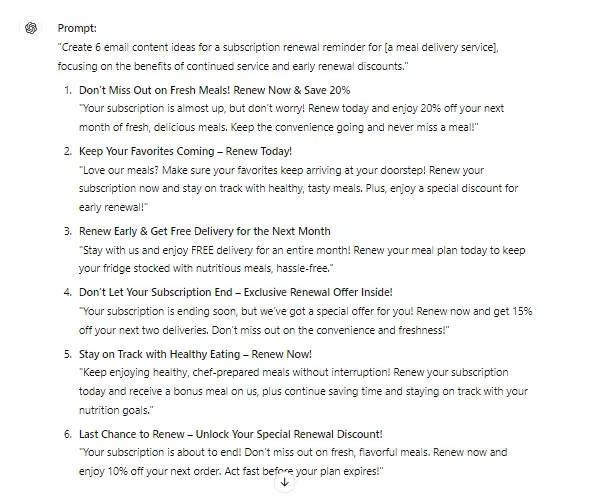
13. Survey or Feedback Request Emails
Asking your customers for feedback can provide valuable insights while also making them feel involved in your brand’s development. Feedback request emails should be short, simple, and include a clear call-to-action that encourages participation. You can request reviews, customer satisfaction surveys, or product feedback. Offering incentives for completing the survey can boost response rates and ensure you get the insights you need to improve your product or service.
Prompt:
"Generate 4 feedback requests email ideas for [an online pet store], including incentives like discounts or loyalty points for survey completion."
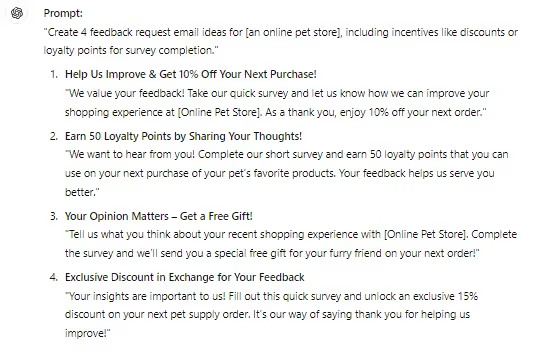
14. Social Media Promotion Emails
Encouraging your email subscribers to follow and engage with your brand on social media can help grow your online presence. These emails should highlight the benefits of following your social accounts, such as gaining access to exclusive content, special offers, or behind-the-scenes insights. Including links to your social media profiles and a clear call-to-action can drive traffic and engagement on your platforms.
Prompt:
"Create 6 social media promotion email ideas for [a beauty brand], encouraging subscribers to follow for exclusive deals and behind-the-scenes content."

Effective Strategies for Using ChatGPT in Email Marketing
Using ChatGPT in your email marketing efforts can streamline content creation and enhance personalization. However, like any tool, it must be used effectively to maximize its potential. Whether you’re generating subject lines, body copy, or calls to action, understanding the best practices for using ChatGPT will help you create emails that resonate with your audience and drive engagement.
Let’s dive into some key strategies to get the most out of ChatGPT in email marketing:
1. Be Specific with Your Prompts
The more context you provide, the better ChatGPT can generate relevant email content. Instead of generic prompts, give clear instructions on the tone, purpose, and target audience of the email. This helps refine the output and ensures it aligns with your campaign goals.
Example: “Generate 3 friendly subject lines for a welcome email for [a skincare brand], targeting first-time customers."
2. Customize the Output for Your Brand Voice
While ChatGPT can generate a wide variety of content, it’s crucial to adjust the output to match your brand’s unique voice. Whether your brand is casual, professional, or humorous, you’ll need to edit and refine the suggestions to fit your tone and style.
Example: "Create 5 playful email body copy ideas for [a pet food company], focusing on new product launches."
3. Use A/B Testing for Different Versions
One of the most effective ways to optimize your email marketing is through A/B testing. With ChatGPT, you can easily generate multiple variations of subject lines or body content to see which performs best. Testing different elements like wording, tone, and urgency can lead to more successful campaigns.
Example: "Generate 5 subject line variations for an email promoting a limited-time offer for [an online fashion store]."
4. Include Personalization Elements
Personalization is key to connecting with your audience, and ChatGPT can help craft personalized content based on customer data like names, preferences, or past purchases. Make sure to ask for specific prompts that allow space for these personalized details, which can improve open and conversion rates.
Example: "Write 3 personalized email body copy ideas for a birthday email campaign for [an eCommerce platform], including spaces for name and birthday gift offers."
5. Focus on Clear Call-to-Actions (CTAs)
Your email’s call to action is one of the most important elements driving engagement. ChatGPT can generate multiple CTA options, but it’s essential to ensure they are clear, actionable, and aligned with your campaign's goals. Use prompts that emphasize strong, direct language to encourage your audience to take the next step.
Example: "Generate 5 persuasive CTA options for a flash sale email for [a fitness equipment store]."
6. Avoid Over-Automation
While ChatGPT can produce large volumes of content quickly, it’s important to avoid over-relying on automated responses. Review and adjust the output to ensure it remains engaging and relevant. Over-automation can lead to generic content, which may hurt your brand’s connection with its audience.
Example: "Generate 3 email copy ideas for a follow-up email after a purchase for [an electronics retailer], with a friendly and personalized tone."
7. Leverage ChatGPT for Follow-Up Sequences
Follow-up emails are essential for keeping your audience engaged after initial interactions. ChatGPT can help create an entire follow-up sequence, guiding customers through their purchase journey or re-engaging inactive users. Use prompts that help map out a series of emails with a consistent tone and message.
Example: "Create a 3-part follow-up email sequence for [a subscription box service], focusing on customer retention and upselling additional products."
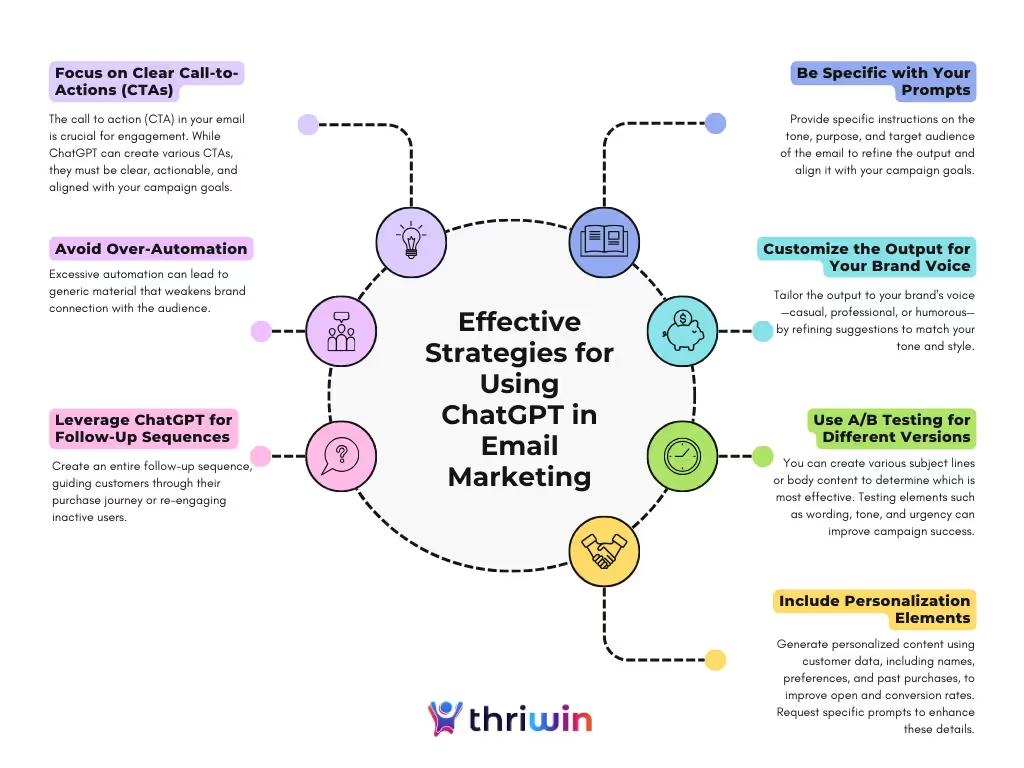
Customizing ChatGPT Prompts for Different Audiences and Industries
Customizing ChatGPT prompts to suit different audiences and industries is key to creating effective and engaging email content. Every industry and target audience requires a unique approach, whether it’s adjusting the tone to match the formality of the sector or tailoring content to address specific customer needs. This guide covers how to tweak ChatGPT prompts for various segments, ensuring the content feels relevant, personalized, and aligned with industry standards.
1. Tone and Language for Industry Types
Different industries often have varying expectations for tone and language. For example, B2B companies in sectors like finance or SaaS may require a more formal, professional tone, while B2C brands in retail or hospitality might benefit from a casual and friendly approach.
- B2B Example (SaaS):
Formal, straightforward language is ideal for professional audiences. Focus on value propositions, industry-specific jargon, and clear benefits.
Prompt: “Generate 5 email subject linB2es for [a SaaS company] that highlight efficiency and time-saving features for busy professionals.”
- B2C Example (Retail):
For retail, a more conversational, engaging tone works best. Infuse the prompt with enthusiasm, humor, or a personal touch.
Prompt: “Create 5 playful email body copy ideas for [a fashion brand], offering exclusive discounts for first-time buyers.”
2. Adapting Content for Different Audiences
Audiences in various sectors expect content that speaks directly to their unique needs. For example, healthcare communications may prioritize empathy and clarity, while tech industries focus on innovation and problem-solving.
- Healthcare:
Healthcare emails should be empathetic, informative, and easy to understand. Use clear language that builds trust with the audience.
Prompt: “Write a caring and informative follow-up email for [a healthcare clinic] reminding patients of their upcoming appointment and benefits of regular check-ups.”
- Technology/Software (B2B):
Tech-related emails should highlight features, innovation, and technical benefits in a way that appeals to decision-makers. Focus on data-driven results and use precise language.
Prompt: “Generate 3 email templates for [a software company] targeting IT professionals, emphasizing product security and scalability.”
3. Formal vs. Casual Tone
Tailoring the tone of your emails is essential to resonate with your audience. A formal tone is often used in industries like finance or legal services, whereas a casual tone works well for eCommerce or entertainment.
- Formal Example (Finance):
Finance emails should communicate professionalism, precision, and trust. Avoid casual language and ensure the tone reflects expertise.
Prompt: “Write a formal email for [a financial advisory firm] introducing a new portfolio management service to high-net-worth clients.”
- Casual Example (Entertainment):
Casual language in entertainment emails can create a fun, engaging experience. Use light, friendly language that aligns with the brand’s playful nature.
Prompt: “Create 5 casual email subject lines for [a streaming service] promoting a weekend movie marathon.”
4. Adjusting for B2B vs. B2C
Understanding whether you’re communicating with a business or a consumer directly impacts your email's structure, tone, and content. B2B emails focus more on efficiency, results, and ROI, while B2C emails often aim for emotional connection and excitement.
- B2B Example: Emails should be professional and concise, focusing on the practical benefits and ROI. The content needs to be data-driven and informative.
Prompt: “Generate 4 professional email copy ideas for [a consulting firm] to send to potential corporate clients, highlighting measurable results and expertise.”
- B2C Example: Emails for consumers should be engaging, often using storytelling or promotions to create a more personal connection.
Prompt: “Write 3 email content ideas for [an online boutique] showcasing new arrivals with a friendly, engaging tone.”
5. Creating Sector-Specific Content
Each sector has unique challenges and language that resonate best with its audience. Whether writing for healthcare, retail, or education, customizing content to address sector-specific needs ensures your emails remain relevant and engaging.
- Retail: Retail emails should emphasize the customer experience, focusing on personalization, promotions, and urgency.
Prompt: “Generate 5 email body copy ideas for [a retail store], promoting a limited-time offer and creating a sense of urgency.”
- Education: Emails for the education sector should be informative, focusing on clarity and support. Highlight benefits for students, parents, or educators.
Prompt: “Create 3 email copy ideas for [an online learning platform], explaining the benefits of new courses in a friendly, supportive tone.”
Choosing the Right CRM for Email Marketing Success
Crafting prompts that fit your audience is essential when using ChatGPT for email marketing. For aggressive growth companies—those scaling more than 50% annually—choosing the right CRM to streamline your email strategy is just as important. Effective email prompts can drive engagement, but you need a CRM that supports fast activation and multi-channel selling to fully leverage them.
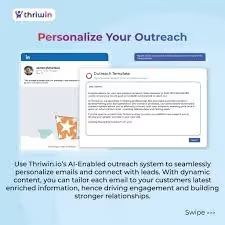
Thriwin, with its pay-per-use model, is designed for companies like yours, offering a 50% cost savings compared to traditional CRMs. It also provides free onboarding support, customization, and quick sales channel activation, ensuring you can execute your email marketing strategy efficiently and start growing revenue fast.
FAQs
- What makes ChatGPT prompts effective for email marketing?
ChatGPT prompts are highly effective for email marketing because they can quickly generate personalized, engaging content tailored to your audience. This saves time, boosts creativity, and improves the overall effectiveness of your campaigns.
- How can Thriwin.io enhance my email marketing efforts?
Thriwin.io offers a pay-per-use CRM that helps you streamline email marketing by providing free onboarding support and customization. It ensures quick activation of sales channels, saving time and boosting revenue growth.
- Why is Thriwin.io suitable for fast-growing companies?
Thriwin.io is designed for companies scaling rapidly, offering a 50% cost savings compared to other CRMs while supporting multi-channel sales strategies and providing hands-on support to optimize email marketing efforts.
- How does Thriwin.io compare to other CRMs like HubSpot or Salesforce?
While HubSpot is great for inbound marketing and Salesforce is tailored for enterprise solutions, Thriwin.io is ideal for fast-growth companies that need quick, cost-effective sales activation with flexible, pay-per-use pricing and comprehensive support.
%201.svg)



